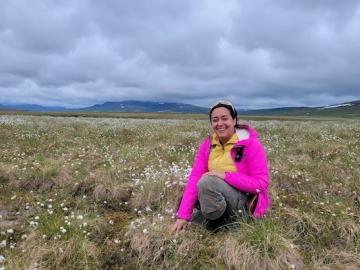
Filter News
Area of Research
- (-) Biology and Environment (177)
- (-) Computational Engineering (5)
- (-) Electricity and Smart Grid (3)
- (-) Neutron Science (190)
- Advanced Manufacturing (34)
- Biological Systems (18)
- Biology and Soft Matter (5)
- Building Technologies (12)
- Chemical and Engineering Materials (4)
- Chemistry and Physics at Interfaces (11)
- Clean Energy (522)
- Climate and Environmental Systems (14)
- Computational Biology (6)
- Computational Chemistry (5)
- Computer Science (19)
- Data (1)
- Earth Sciences (1)
- Energy Frontier Research Centers (14)
- Energy Sciences (5)
- Fossil Energy (3)
- Fuel Cycle Science and Technology (3)
- Functional Materials for Energy (16)
- Fusion and Fission (54)
- Fusion Energy (17)
- Geographic Information Science and Technology (3)
- Isotope Development and Production (3)
- Isotopes (35)
- Materials (433)
- Materials Characterization (2)
- Materials for Computing (36)
- Materials Synthesis from Atoms to Systems (13)
- Materials Under Extremes (12)
- Mathematics (1)
- National Security (79)
- Neutron Data Analysis and Visualization (4)
- Nuclear Science and Technology (74)
- Nuclear Systems Modeling, Simulation and Validation (3)
- Nuclear Systems Technology (1)
- Quantum Condensed Matter (4)
- Quantum information Science (9)
- Reactor Technology (1)
- Renewable Energy (4)
- Sensors and Controls (5)
- Supercomputing (311)
- Transportation Systems (11)
News Type
News Topics
- 3-D Printing/Advanced Manufacturing (15)
- Advanced Reactors (2)
- Artificial Intelligence (16)
- Big Data (11)
- Bioenergy (50)
- Biology (75)
- Biomedical (27)
- Biotechnology (13)
- Buildings (3)
- Chemical Sciences (13)
- Clean Water (14)
- Climate Change (42)
- Composites (5)
- Computer Science (34)
- Coronavirus (18)
- Critical Materials (1)
- Cybersecurity (1)
- Decarbonization (22)
- Energy Storage (14)
- Environment (99)
- Exascale Computing (4)
- Fossil Energy (1)
- Frontier (5)
- Fusion (1)
- Grid (6)
- High-Performance Computing (24)
- Hydropower (8)
- Isotopes (2)
- Machine Learning (12)
- Materials (26)
- Materials Science (29)
- Mathematics (4)
- Mercury (7)
- Microelectronics (1)
- Microscopy (13)
- Molten Salt (1)
- Nanotechnology (17)
- National Security (5)
- Net Zero (2)
- Neutron Science (99)
- Nuclear Energy (4)
- Partnerships (5)
- Physics (11)
- Polymers (3)
- Quantum Computing (1)
- Quantum Science (7)
- Renewable Energy (1)
- Security (4)
- Simulation (15)
- Space Exploration (3)
- Summit (16)
- Sustainable Energy (33)
- Transformational Challenge Reactor (1)
- Transportation (8)
Media Contacts

When Hurricane Maria battered Puerto Rico in 2017, winds snapped trees and destroyed homes, while heavy rains transformed streets into rivers. But after the storm passed, the human toll continued to grow as residents struggled without electricity for months. Five years later, power outages remain long and frequent.

With wildfires increasing in scope and intensity around the world, Fernanda Santos’ research into how such calamities affect soil carbon storage has taken on new urgency.

Global carbon emissions from inland waters such as lakes, rivers, streams and ponds are being undercounted by about 13% and will likely continue to rise given climate events and land use changes, ORNL scientists found.

Five technologies invented by scientists at the Department of Energy’s Oak Ridge National Laboratory have been selected for targeted investment through ORNL’s Technology Innovation Program.

Researchers at the Department of Energy’s Oak Ridge National Laboratory and their technologies have received seven 2022 R&D 100 Awards, plus special recognition for a battery-related green technology product.

Scientists at ORNL have created a miniaturized environment to study the ecosystem around poplar tree roots for insights into plant health and soil carbon sequestration.

A team of scientists led by Oak Ridge National Laboratory developed a theory that thylakoids, membrane networks key to plant photosynthesis, also function as a defense mechanism to harsh growing conditions, which could aid the development of hardier plants.

Oak Ridge National Laboratory researchers are developing a first-of-its-kind artificial intelligence device for neutron scattering called Hyperspectral Computed Tomography, or HyperCT.

Scientists at ORNL used neutron scattering to determine whether a specific material’s atomic structure could host a novel state of matter called a spiral spin liquid.

Chemical and environmental engineer Samarthya Bhagia is focused on achieving carbon neutrality and a circular economy by designing new plant-based materials for a range of applications from energy storage devices and sensors to environmentally friendly bioplastics.


